Santa Catalina Island, California
 Santa Catalina Island satellite image |
|
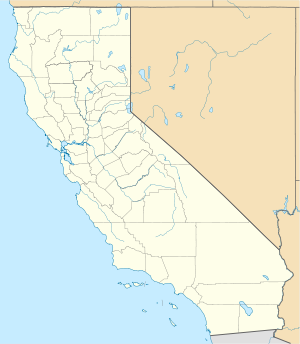 Santa Catalina Island
Santa Catalina Island (California)
|
|
| Geography | |
|---|---|
| Location | Pacific Ocean |
| Archipelago | Channel Islands of California |
| Area | 74.98 sq mi (194.2 km2) |
| Highest elevation | 2,097 ft (639.2 m) |
| Highest point | Mt. Orizaba |
| Country | |
|
United States
|
|
| State | |
| County | Los Angeles |
| Largest city | Avalon (pop. 3,127) |
| Demographics | |
| Population | 3,696 |
| Density | 19.03 /km2 (49.29 /sq mi) |
Santa Catalina Island, often called Catalina Island, or just Catalina, is a rocky island off the coast of the U.S. state of California. The island is 22 miles (35 km) long and 8 miles (13 km) across at its greatest width. The island is located about 22 miles (35 km) south-southwest of Los Angeles, California. The highest point on the island is 2,097 feet (639 m) Mt. Orizaba, at .
Part of the Channel Islands of California archipelago, Catalina falls under the jurisdiction of Los Angeles County. Most of the island is owned by the Catalina Island Conservancy.
The total population as of the 2000 census was 3,696 persons with almost 85 percent living in its only town of Avalon (pop. 3,127, with another 195 south of the town outside of the town limits). The second center of population is the unincorporated village of Two Harbors, in the north, with a population of 298. Development occurs also at the smaller settlements Rancho Escondido and Middle Ranch. The remaining population is scattered over the island between the two population centers. The island has an overall population density of 49.29/mi² (19.03/km²).
Contents |
History
Early history
Prior to the modern era, the island was inhabited by people of the Gabrielino/Tongva tribe, who, having had villages near present day San Pedro and Playa del Rey, regularly traveled back and forth to Catalina for trade. The Tongva called the island Pimu or Pimugna and referred to themselves as the Pimugnans. Archeological evidence shows Tongva settlement beginning in 7000 BC. These Pimugnans had settlements all over the island at one time or another, with their biggest villages being at the Isthmus and at present-day Avalon, Shark/Little Harbor, and Emerald Bay. The Gabrielino/Tongva are renowned for their mining, working and trade of soapstone which was found in great quantities and varieties on the island. This material was in great demand and was traded along the California coast and as far south as Baja California.

The first European to set foot on the island was Portuguese explorer Juan Rodriguez Cabrillo, sailing for Spain. On October 7, 1542, he claimed the island for Spain and christened it San Salvador after his ship (Catalina has also been identified as one of the many possible burial sites for Cabrillo). Over half a century later, another Spanish explorer, Sebastian Vizcaino, rediscovered the island on the eve of Saint Catherine's day (November 24) in 1602. Vizcaino renamed the island in the saint's honor.[1]
During the next 300 years, the island served as home or base of operation for many visitors, including Russian otter hunters, Yankee smugglers and itinerant fishermen. Among these visitors, the Aleuts of Russian Alaska probably had the largest effect on the island and its people. These otter-hunters from the Aleutian Islands set up camps on Santa Catalina, and the surrounding Channel Islands, trading with the native peoples in exchange for permission to hunt otters and seals around the island for their pelts. The Aleuts brought diseases to the natives of Santa Catalina Island, for which they had no immunity. This, ultimately, led to the demise of the Pimugnan people. Although these hunters had been known to lead attacks on the native people of surrounding islands, such as the massacre that took place on San Nicolas Island, there is no evidence of such an event on Santa Catalina. (See Nicoleno). Smuggling also took place on the island for a long period of time. Pirates found that the island's abundance of hidden coves, as well as its short distance to the mainland and its small population, made it suitable for smuggling activities. Once used by smugglers of illegal Chinese immigrants, China Point, located on the south western end of Catalina, still bears its namesake.
Franciscan Friars considered building a mission there, but abandoned the idea because of the lack of fresh water on the island. By the 1830s, the entire island's native population were either dead, or had migrated to the mainland to work in the missions or as ranch hands for the many private land owners.
Mexican land grant
Governor Pío Pico made a Mexican land grant of the Island of Santa Catalina to Thomas M. Robbins in 1846, as Rancho Santa Catalina. Thomas M. Robbins (1801–1854) a sea captain who came to California in 1823, married the daughter of Carlos Antonio Carrillo. Robbins established a small rancho on the Island, but sold it in 1850 to Jose Maria Covarrubias. A claim was filed with the Public Land Commission in 1853,[2] and the grant was patented to José Maria Covarrubias in 1867.[3] Covarrubias sold the island to Albert Packard of Santa Barbara in 1853, and by 1864 the entire island was owned by James Lick.
The island experienced a brief gold rush in 1860s, but very little gold was actually found. In 1864, the federal government, fearing attempts to outfit privateers by Confederate sympathizers in the American Civil War, put an end to the mining by ordering everyone off the island. A small garrison of Union troops were stationed at the Isthmus on the island's west end for about nine months. Their barracks stand as the oldest structure on the island and is currently the home of the Isthmus Yacht Club.
Early developers
By the end of the 19th century, the island was almost uninhabited except for a few cattle herders. At that time, its location just 20 miles (30 km) from Los Angeles—a city that had reached the population of 50,000 in 1890 and was undergoing a period of enormous growth—was a major factor that contributed to the development of the island into a vacation destination.
The first owner to try to develop Avalon into a resort destination was George Shatto, a real estate speculator from Grand Rapids, Michigan. Shatto purchased the island for $200,000 from the Lick estate at the height of the real estate boom in Southern California in 1887.[4] Shatto created the settlement that would become Avalon, and can be credited with building the town's first hotel, the original Hotel Metropole, and pier[4]. His sister-in-law Etta Whitney came up with the name Avalon, which was taken from Alfred, Lord Tennyson's poem "Idylls of the King," about the legend of King Arthur. He laid out Avalon's streets, and introduced it as a vacation destination to the general public. He did this by hosting a real estate auction in Avalon in 1887, and purchasing a steamer ship for daily access to the island. In the summer of 1888, the small pioneer village kicked off its opening season as a booming little resort town. Despite Shatto's efforts, he defaulted on his loan after only a few years and the island went back to the Lick estate.
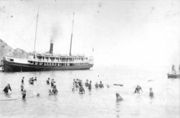
The sons of Phineas Banning bought the island in 1891 from the estate of James Lick and established the Santa Catalina Island Company to develop it as a resort. The Banning brothers fulfilled Shatto's dream of making Avalon a resort community. They built a dance pavilion in the center of town, made additions to the Hotel Metropole and steamer-wharf, built an aquarium, created the Pilgrim Club (a gambling club for men only), improved the standard of Avalon's beach by erecting a sea-wall and adding covered benches or "spoonholders", building a bath house, adding new steamships to the run, and setting up close to one hundred tents throughout Avalon's canyon (often called "tent cities"). These tents were created so that, if the expense of a hotel was too much, a visitor could rent out a tent for as little as $7.50 per week, which was quite a bargain at the time. To this day, many homes in Avalon are still in possession of the same tents that stood in that spot over a century ago.
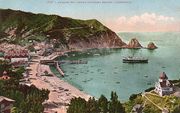
Although the Banning's main focus was in Avalon, they also showed great interest in the rest of the island and wanted to introduce other parts of Catalina to the general public. They did this by paving the first dirt roads into the island's interior where they built hunting lodges and led stagecoach tours, and by making Avalon's surrounding areas (Lovers Cove, Sugarloaf Point and Descanso Beach) accessible to tourists. They built two homes, one in Descanso Canyon and the other in what is now Two Harbors, the later now being that village's only hotel. Just as the Bannings were anticipating construction of the new Hotel Saint Catherine, their efforts were set back on November 29, 1915, when a fire burned half of Avalon's buildings, including six hotels and several clubs. The Bannings refused to sell the island in hopes of rebuilding the town, starting with the Hotel Saint Catherine. The hotel would be located on Sugarloaf Point, the unique, picturesque, cliff-bound peninsula at the north end of Avalon's harbor. It was blasted away to begin the construction of the hotel with its annex being in Descanso Canyon. These plans failed because of lack of funding and, in the end, the entire hotel was built in Descanso Canyon. The Bannings were in huge debt from the fire of 1915 and World War I's negative effect on tourism in general. In 1919, the Banning brothers were forced to sell the island in shares.
Wrigley ownership
One of main investors to purchase shares from the Bannings was chewing gum magnate William Wrigley, Jr. He was convinced to invest in Santa Catalina Island and, before his purchase, he traveled to Catalina with his wife, Ada, and son, Philip. Wrigley immediately fell in love with the island, and he bought out every last share-holder until he owned the controlling share of the Santa Catalina Island Company.
When William Wrigley Jr. bought controlling interest in the Santa Catalina Island Company in 1919, he devoted himself to preserving and promoting it, investing millions in needed infrastructure and attractions.
When the island was bought, two ships, the Hermosa II and the S.S. Cabrillo were the only steamships that provided access to the island. Wrigley understood that transportation to and from the island was vital to Catalina's growth. He envisioned great steamers, some of the greatest the world had ever seen. He purchased the S.S. Virginia, and with some adjustments, it was renamed the S.S. Avalon in 1920. He foresaw the design of another steamship, the S.S. Catalina which was launched on the morning of May 3, 1924. Each of these ships weighed over 2,000 tons, and could hold more than 1,500 passengers. These steamships would deliver passengers to Catalina for many years.
In the 1920s, in an effort to generate tourism on Catalina, Wrigley tried to convince Gertrude Ederle, who had just become famous as first woman to swim across the English Channel, to swim from Catalina to the mainland. She declined, so he launched the 1927 Wrigley Ocean Marathon: offering $25,000 to the first person to cross the channel, with $15,000 for the first finisher of "the fair sex." Out of a field of 102, only one man completed the swim, Canadian swimmer George Young, who finished 15 hours and 44 minutes after the start. The two women who came the closest were awarded $2,500 each.[5]
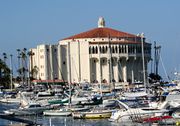
Wrigley built a home in Avalon to oversee his plans. One of Wrigley's first priorities was to create a new and improved dance pavilion for the island's tourists. Before the Banning brothers sold the island, Sugarloaf Point was blasted away to start the construction of the Hotel St. Catherine. In the end, the hotel was built in Descanso Canyon. However, Wrigley used this cleared spot to build the dance hall which he named Sugarloaf Casino. It served as a ballroom and Avalon's first high-school. Its time as a casino was short, however, for it proved too small for Catalina's growing population. In 1928, the Casino was razed to make room for a newer Casino. Sugarloaf Rock was blasted away to enhance the Casino's ocean-view.
Tourism was encouraged by the construction of an Art Deco dance hall, called the Catalina Casino, on May 29, 1929. Surrounded by sea on three sides, the circular structure is the equivalent of 12 stories tall.
The lower level of the Casino houses the Avalon Theater. The upper level houses the world's largest circular ballroom with a 180-foot (55 m) diameter dance floor. French doors encircle the room, and balcony views are spectacular.
| “ | The gorgeous Catalina Island Casino is a two million dollar "Palace of Pleasure" located midway between Hotel St. Catherine and the town of Avalon. It is the only building of its size in the world erected on a full circular plan. A mammoth motion picture theater is on the ground floor and, above, the world's largest circular ballroom. | ” |
Recent history
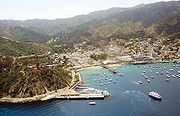
From 1927 through 1937, pottery and tile were made on the island at the Catalina Clay Products Company, and these items are now highly sought-after collectibles.[6] The Chicago Cubs, also owned by Wrigley, used the island for the team's spring training from ca. 1921-1951, absent the war years of 1942-45.
During World War II, the island was closed to tourists and used for military training facilities.[7] Catalina's steamships were expropriated for use as troop transports, the U.S. Maritime Service set up a training facility in Avalon, the Coast Guard had training at Two Harbors, the Army Signal Corp maintained a radar station in the interior, and the Office of Strategic Services (a precursor to the CIA) did training at Toyon Bay.[1] Emerald Bay, on the Island's west end was used by the Navy.
Catalina's airport, the "Airport in the Sky" (AVX), was completed in 1946. The 3,250-foot (990 m) runway sits on a mountaintop, 1,602 feet (488 m) above sea level. Until the time of the airport's construction, the only air service to the island was provided by seaplanes.
In September 1972, 26 members of the Brown Berets, a group of Chicano activists, traveled to Catalina and planted a Mexican flag, claiming the island for all Chicanos. They asserted that the Guadalupe Hidalgo Treaty between Mexico and the United States did not specifically mention the Channel Islands. The group camped outside of Avalon and were viewed as a new tourist attraction. Local Mexican-Americans provided them with food after they used up their own supplies. After 24 days a municipal judge visited the camp to ask them to leave. They departed peaceably on the tourist boat, just as they had arrived.[8]
In 1975, Philip Wrigley deeded the Wrigley shares in the Santa Catalina Island Company to the Catalina Island Conservancy that he had helped create. The Conservancy now stewards 88 percent of the island. The mission of the Catalina Island Conservancy is to be a responsible steward of its lands through a balance of conservation, education and recreation. So far, the successes include the opening of California's first permanent desalination plant in 1991.
In May 2007, the town was threatened once again by a wild fire. Because of the help of 200 Los Angeles County Fire Fighters brought over by Marine Corps hovercraft, only a few structures were destroyed.[9]
Geology
The island is very rich in quartz, to the point that some beaches on the seaward side have silvery-grey sand.
Catalina is primarily composed of two distinct rock units, Catalina Schist from the Cretaceous and volcanic and intrusive igneous rocks from the Tertiary period.
Wildlife
In addition to thousands of more widespread species of plants and animals, Catalina is home to 15 taxa found nowhere else.
Flora

About 400 species of native plants grow on the island[10]. Six species, subspecies or varieties are endemic and can be found only on Catalina Island. These plants are: Catalina manzanita (Arctostaphylos catalinae); Catalina mahogany (Cercocarpus traskiae); Catalina dudleya (Dudleya hassei); St. Catherine’s lace (Eriogonum giganteum var. giganteum); Santa Catalina bedstraw (Galium catalinense ssp. catalinense); and Santa Catalina Island ironwood (Lyonothamnus floribundus ssp. floribundus). A disjunctive population of Toyon var. macrocarpa[11] is also a Santa Catalina endemic.
These plants may be seen at the island's Wrigley Memorial & Botanical Gardens and the newly remodeled Golf Gardens miniature golf course.
Fauna
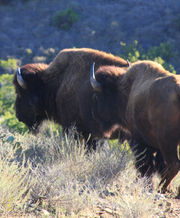
The island is home to five native land mammals: the Island Fox, the Spermophilus beecheyi nesioticus subspecies of California Ground Squirrel, the Santa Catalina Island Harvest Mouse (Reithrodontomys megalotis catalinae), the Santa Catalina Island Deer Mouse (Peromyscus maniculatus catalinae), and the Ornate Shrew (Sorex ornatus). Only one Ornate Shrew was ever found, from a now-developed spring area above Avalon. Shrews are difficult to capture and may survive in wetter areas of the island.[12]
Sea otters are now extinct on Santa Catalina Island and surrounding waters because of the effects of the Aleut hunts. These hunts took place for months in the 19th century, with the slaughtering of close to one hundred otters per night. Today, the only substantial population of sea otters in the area is off the northern Channel Islands.
The Island Fox is an endangered endemic species. In 1999, all but 100 out of 1,300 foxes on Catalina Island were wiped out because of a virulent strain of canine distemper. Following a successful recovery program which included captive breeding, distemper vaccinations and population monitoring, the Catalina fox community has been restored to more than 400 individuals—a number deemed by the Conservancy scientists to be a self-sufficient population.[13] However, mysterious, usually fatal ear tumors continue to plague the Catalina fox. Three Catalina Island Conservancy wildlife biologists continue to monitor the population through pit tagging, trapping and inspection.
The Conservancy is also working to restore bald eagles to the island, with several chicks hatching in 2007. These would edge out an invasive golden eagle population that threatens the native Island Fox. DDT, which was used before as a pesticide, softened the shell of the egg, which made it harder for the egg to reach its hatching.
The island has been home to a population of approximately 150 American bison since 1924. Originally, fourteen bison were brought to the island for the filming of the movie The Vanishing American, though the scenes with the bison in them did not make it into the final cut of the film. Due to cost overruns, the film company decided to leave the bison on the island instead of bringing them back to the mainland.[14]
In the waters surrounding the island, there are schools of fish like garibaldi, Yellowtail, Kelp Bass, White seabass, Giant sea bass, Leopard sharks, blacksmiths, opaleyes, sheepheads, lingcods, bat rays, horn sharks, mackerel, bonito, barracuda, herring, anchovies, sardines, and many more. The great white shark has also been found on the west side of the island among the kelp beds.
The Catalina Orangetip butterfly is a notable insect of the island.
The island also has an abundance of deadly Rattlesnakes in the back country, which manage to control the rodent population.
Tourism and attractions
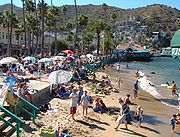
About a million tourists visit the island every year; Catalina is serviced by ferries and the "Airport in the Sky." Ferries depart from Orange County in Newport Beach and Dana Point, while they depart from Los Angeles County in Long Beach, San Pedro, and Marina del Rey. The trip takes approximately an hour and costs approx $65 round trip. Helicopter service is also available from Long Beach or San Pedro.
Most of the island is controlled by the Catalina Island Conservancy, a private nonprofit organization. The mission of the Catalina Island Conservancy is to be a responsible steward of its lands through a balance of conservation, education and recreation. Through its ongoing efforts, the Conservancy protects the magnificent natural and cultural heritage of Santa Catalina Island, stewarding approximately 42,000 acres (170 km²) of land (88 percent of the island), 50 miles (80 km) of rugged shoreline, an airport, and more than 200 miles (300 km) of roads.
Under an agreement with Los Angeles County, the Conservancy has granted an easement to allow day hiking and mountain biking, but visitors must first obtain a permit at the Conservancy's office (on which they declare the parts of the island they intend to visit). Hiking permits are free, whereas bicycle permits are available for a fee (as of 2006, $60 per person annual, $20 per person good for 2 consecutive days, helmets and mountain bikes with knobby tires required).
The use of motor vehicles on the island is restricted; there is a limit on the number of registered cars, which translates into a 10-year-long wait list to bring a car to the island. Most residents move around via golf cart. Tourists can hire a taxi from Catalina Transportation Services. Bicycles are also a popular mode of transportation. There are a number of bicycle and golf cart rental agencies on the island. Only the city of Avalon is open to the public without restrictions.
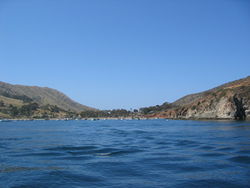
The only major road into the back country is Stage Road.
Glass bottom boats tour the reefs and shipwrecks of the area, and scuba diving and snorkeling are popular in the clear water. Lover's Cove, to the east of town, and Descanso Beach, to the west of the Casino, are popular places to dive. The area is famous for the schools of flying fish and the bright orange Garibaldi which teem in local waters. Bus tours are given of the interior.
While tourists rarely have an opportunity to surf, two beaches on the "backside" of Catalina offer good waves: Shark Harbor and Ben Weston Beach.
Two Harbors is the second, and much smaller, resort village on the island. Located at the isthmus of the island, north of Avalon, it is the primary landing spot for those who wish to tour the western half of the island. It is accessible by boat from San Pedro and by bus or boat from Avalon.
Art Good, host of the Jazztrax Showcase of the Absolute Newest, holds the Catalina Island Jazztrax Festival there each year.
The Catalina Island Museum, located in the historic Catalina Casino building, is also an attraction as it is the keeper of the island's cultural heritage with collections numbering over 100,000 items and including over 7,000 years of Native American history, over 10,000 photographs and images, a large collection of Catalina-made pottery and tile, ship models, and much more. The museum features dynamic exhibits on this history and also a unique gift store. Programs include walking tours of Avalon, classes for students, gallery docents, lectures, an annual silent film benefit and more.
Shipwrecks
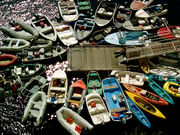
Known shipwrecks in the waters off the island include the Diosa del Mar (), which was sunk July 30, 1990 near Ship Rock, and the famous Su-Jac (among others) just off Casino point. The yacht Valiant burned and sank a couple hundred yards out from Descanso Beach. It had about $75,000 worth of jewelry on board which has never been recovered.
The oldest shipwreck known on Santa Catalina Island is that of a Chinese smuggling ship off Ballast Point on the west side of the island.
Dives are by harbormaster's permit only.
Camping
The Santa Catalina Island Company has campgrounds at Two Harbors, Parson's Landing, Black Jack, Little Harbor, and Hermit Gulch inland from Avalon. All campgrounds require a reservation and permit. There are also nine primitive boat-in only campgrounds.
Two Boy Scouts of America councils in Los Angeles County have camps north of Two Harbors: Camp Cherry Valley, operated by the San Gabriel Valley Council, located two coves north of Two Harbors at Cherry Cove; and Camp Emerald Bay, operated by the Western Los Angeles County Council, further up the coast.
The island contains another camp named Camp Fox, formerly operated by the YMCA of Glendale, which holds several summer coed youth camps, a summer girl's camp, as well as a Christian leadership conference in spring. As of 2007 Camp Fox also known as Fox Landing is currently owned by the Catalina Island Marine Institute. There is also Campus by the Sea, a camp operated by InterVarsity Christian Fellowship, located at Gallagher's Cove.
There is also a coeducational camp at Howland's Landing named Catalina Island Camps, which has been there since the 1920s. Catalina Island Camps is home to many camps including Camp del Corazon, a camp for kids and counslers with heart disease or defects.
Guided Discoveries (Catalina Island Marine Institute) also runs several camps (Toyon Bay, Fox Landing, and Cherry Cove) on Catalina Island providing hands on opportunities to learn marine science (at Toyon Bay) and environmental studies to school groups and community groups during school year and sea camps during the summer.
Yacht clubs
Moonstone is another private cove operated by the Newport Harbor Yacht Club of Newport Beach, California.
Just west of Moonstone Cove is Whites Landing. Whites Landing is home to two yacht club camps, Balboa Yacht Club to the west, and San Diego Yacht Club to the east. In the center of the large cove on a 14-acre (57,000 m2) parcel is a private camp and retreat center called the Catalina Experience. The Catalina Experience hosts numerous youth camps, family camps, group retreats and outdoor education programs.

Government and infrastructure
The Los Angeles County Sheriff's Department (LASD) operates the Avalon Station in Avalon, serving Santa Catalina Island.[15]
Education
Children in Avalon attend schools in the Long Beach Unified School District.
There are two schools on Catalina Island. Two Harbors is served by a one-room school house for grades K-5; students travel to Avalon for grades 6-12. Avalon schools are housed on one main campus that includes Avalon Elementary School, Avalon Middle School and Avalon High School. About a dozen children attend the Two Harbors school and about 800 students attend Avalon schools each year. Thousands of school-age youths travel from the mainland to study at the Catalina Island Marine Institute every year.
The USC Wrigley Institute research and teaching facilities at Big Fisherman's Cove, near Two Harbors, maintained by the University of Southern California and named for Philip K. Wrigley, consist of a 30,000-square-foot (3,000 m2) laboratory building, dormitory housing, cafeteria, a hyperbaric chamber, and a large waterfront staging area complete with dock, pier, helipad, and diving lockers. The facility was made possible by a donation from the Wrigley family.
Culture
In its heyday in the 1930s, due to its proximity to Hollywood, Catalina Island was a favored getaway destination for Hollywood stars such as Clark Gable. The island also served as a filming location for dozens of movies.[1]
Filming location and setting

- The 1920 silent film Terror Island, starring Harry Houdini and directed by James Cruze, was filmed on Catalina Island.
- The 1924 silent comedy film The Navigator, directed by and starring Buster Keaton, was filmed over a 10 week period in Avalon Bay on Catalina Island.
- In 1935, the short film Pirate Party on Catalina Isle featured a pirate-themed variety show set on the island.[16]
- Several scenes in the 1966 romantic comedy film The Glass Bottom Boat, starring Doris Day and Rod Taylor, were filmed in and around Avalon and Avalon Harbor on Catalina Island.
- The 1967 teen comedy film Catalina Caper, starring Tommy Kirk, was filmed on Santa Catalina Island. This movie was later featured in episode 204 of Mystery Science Theater 3000.
- Several scenes from the 1974 film Chinatown, starring Jack Nicholson and Faye Dunaway, were filmed on Catalina, including one showing the Casino.
- A 1976 episode of Quincy, M.E. called Hot Ice, Cold Heart, starring Jack Klugman, Robert Alda and Lynnette Mettey, were filmed on Catalina, showing various parts of the Avalon Harbor and parts of Avalon.
- Catalina was one of the settings for the 1977 CBS TV series Code R.
- In 1984, Catalina and the Avalon Casino were the filming locations for the "Airwolf" episode titled "Sins of the Past", though the island was given a fictional name.
- In 1989, actor Chad Allen is seen visiting Santa Catalina Island in the promotional video The Real Chad Allen. Allen is seen visiting Avalon there and also snorkeling off the coast in the vicinity of a sunken ship.
- The closing sequence of the 1997 film "Suicide Kings", starring Christopher Walken, Denis Leary, Sean Patrick Flanery, Johnny Galecki, Jay Mohr, Jeremy Sisto, and Henry Thomas is a sequence of aerial shots from various parts of Catalina Island. A long flying pan out the western harbor of the Two Harbors isthmus starts the sequence.
- In 1993, the daytime soap opera The Bold and the Beautiful filmed on Catalina for several episodes, most notably at The Inn on Mount Ada.
- Portions of the 1998 film Billy's Hollywood Screen Kiss, starring Sean Hayes and Brad Rowe, utilize the Catalina ferry terminal in San Pedro, California as well as locations on Catalina Island, including Avalon Harbor and the Casino building. The film also closes with a song titled Love Slave of Catalina.
- In 2002, the TV show Endurance was filmed on Parson's Beach, near the west end of the island.
- In a 2004 season one episode of the Fox series Arrested Development titled "Staff Infection," employees of the Bluth Company get lost on Catalina Island, and are found and transported by a sheep herder in his animal trailer.
- The 2006 TV Comedy Falling in Love with the Girl Next Door, featuring Crystal Allen, Ken Marino and Patrick Duffy takes place on Catalina Island.
- Featured in the lyrics of a song called 'Pasadena' by Modern Skirts - 'let's move to Pasadena.. and then on to Catalina.'
- The ending to the 2008 film Step Brothers is supposed to be a wine mixer on the island of Catalina but actually got filmed at the Trump National Golf Course. "Step Brothers: Filming Locations". http://www.seeing-stars.com/Locations/StepBrothers.shtml. Retrieved 5 July 2009..
- In the MTV reality series Daddy's Girls, Angela and Vanessa decide to spy on their friend, Alycia. As pay back for them spying, their cousin Jessica, lies and tells them that Alycia went to Catalina, leading Angela and Vanessa to spend hours searching the island.
- The ending of the movie Crank: High Voltage is in Catalina.
Notable visitors and residents
- General George S. Patton Jr. met his wife Beatrice (Ayer) on Catalina when they were children.
- In 1936, Ronald Reagan, a young radio announcer for WHO in Des Moines, Iowa, traveled to Catalina to cover the Cubs during spring training. While there, he took a screen test and was offered an acting role.
- After visiting Catalina Island, Jack Owens, the Cruising Crooner, a popular radio vocalist of Don McNeil's Breakfast Club, was inspired by the friendly greeting people used there, "Hi, Neighbor," and wrote the music and words in 1941 for a song of the same name. It went on to be a top-selling pop tune that year.
- In the early 1940s during World War II, Marilyn Monroe, as a young, married woman, briefly lived in Avalon with her first husband, James Dougherty, a lieutenant in the Merchant Marine, who was stationed on the island. Monroe often was a babysitter for neighborhood children.
- On May 31, 1950, actor Gregory Harrison was born in Avalon. His father, Ed Harrison, operated a glass-bottom boat sightseeing service on the island. Harrison went on to star in many stage, screen and television productions, including Logan's Run, Trapper John, M.D., Centennial, and It's My Party. In 1980, Harrison and a partner founded an entertainment production company, the Catalina Production Group Ltd., named after his island birthplace.
- Actor Ed Hinton was killed at the age of 30 in an airplane crash on Catalina Island on October 12, 1958.
- Actress Natalie Wood drowned off the coast of Catalina on November 29, 1981, while on a boating trip with husband Robert Wagner and actor Christopher Walken.
- In 2001, while vacationing on a yacht off Catalina, Lisa Marie Presley allegedly got in to a fight with boyfriend Nicolas Cage and threw a famous ring, once owned by her father Elvis Presley, overboard. The ring was worth approximately $65,000.
- Spencer Davis, Welsh musician, Spencer Davis Group lives in Avalon. He can be found regularly accompanying other musicians on stage at such establishments as The Lobster Trap, Luau Larry's and The St. Catherine.
In popular culture
- In 1940, Raymond Chandler in Farewell, My Lovely mentioned Catalina Island as the place his detective, Philip Marlowe, "damn near" hit while vomiting after a sip of a particularly bad whisky.
- In 1958, the Four Preps recorded the hit song "26 Miles (Santa Catalina)"; the song reached the #2 position on the U.S. popular music charts. The metric distance of "40 kil-o-meters" also is sung.
- In 1982, the group Descendents released the album Milo Goes to College, featuring a song called "Catalina."
- In Kim Staley Robinsons's 1984 novel The Wild Shore (part of the Three Californias Trilogy), the island of Catalina is mentioned repeatedly as the offshore home of the Japanese, who have been mandated by the U.N. to watch over the United States after it had been decimated by a nuclear attack.
- Catalina Island is briefly mentioned in the 1987 movie Lethal Weapon as the place where Roger (Danny Glover) would like to fish with his new boat.
- The 1988 film Who Framed Roger Rabbit featured an oft-referenced vacation to Santa Catalina Island as a subject in the failing relationship between Eddie Valiant and Dolores.
- In Dan Brown's popular novel Deception Point, published in 2001, there is a reference to sailing off the coast of Catalina.
- In Sandra Byrd's Faithful Friends: The Hidden Diary Series (published in 2001), the main setting and location for all the books is Santa Catalina Island.
- In Michael Connelly's 2001 novel A Darkness More Than Night Santa Catalina Island is featured extensively.
- Catalina's long association with the Chicago Cubs baseball team is the subject of the 2003 book, The Cubs on Catalina, by Jim Vitti . . . which was named International 'Book of the Year' by The Sporting News.
- In Dave Freedman's 2006 novel Natural Selection, Santa Catalina Island is mentioned briefly in the first chapter.
- The island is the location of some key action scenes in the 2007 novel Falling by Christopher Pike.
- The Island lends its name to a local weather pattern, the Catalina eddy.
- In the 2009 short story Getting Real by Harry Turtledove, a bankrupt United States had ceded the Channel Islands to China in settlement of unpaid debts. China maintained its diplomatic residence in Avalon.
- In the episode of Veronica Mars entitled "Aint No Magic Mountain High Enough", Weevil bemoans the student council's decision to make the senior class trip to Catalina, believing the student body would rather visit the Magic Mountain theme park.
- In Jeffrey West's 2009 novel Avalon, Catalina Island is attacked by international terrorists in a complex conspiracy to empower a foreign leader.
- In the 2008 film Step Brothers, Catalina was the site of "The Fucking Catalina Wine Mixer"
- Catalina Island figures prominently in Kage Baker's Company science fiction book series.
See also
- Channel Islands of California
- Catalina Island buffalo herd
- Island Fox
- Tongva
- Tongva language
References
- ↑ 1.0 1.1 1.2 Otte, Stacey; Pedersen, Jeannine (2004). "Catalina Island History". A Catalina Island History in Brief. Catalina Island Museum. http://www.catalinamuseum.org/history.html. Retrieved January 28, 2008.
- ↑ United States. District Court (California : Southern District) Land Case 368 SD
- ↑ Report of the Surveyor General 1844 - 1886
- ↑ 4.0 4.1 Jessica Gelt, A day in: 90704, Los Angeles Times, January 7, 2007
- ↑ James Rainey, Crossing the icy waters for posterity, Los Angeles Times, October 18, 2005.
- ↑ http://catalinacollectors.org/blog/articles/carole_coates.html Catalina Island Pottery and Tile: Setting the Scene, excerpt from the book Catalina Island Pottery & Tile: Island Treasures by Carole Coates
- ↑ Catalina Island Life During WWII, by Jeannine Pedersen, Curator of Collections, Catalina Island Museum
- ↑ MARTINEZ, AL (1972-09-23). "Judge Asks Berets to Leave--They Do". Los Angeles Times (1886-Current File): pp. B1. ISSN 04583035.
- ↑ Sahagun, L. and S. Quinones. 2007. Catalina fire lays siege to Avalon: Hundreds of residents and tourists are forced to flee the island. Los Angeles Times. 11 May.
- ↑ Lili Singer, A plant pilgrimage, Los Angeles Times, August 10, 2006.
- ↑ C. Michael Hogan, (2008) Toyon (Heteromeles arbutifolia), GlobalTwitcher, ed. N. Stromberg [1]
- ↑ Schoenherr, Allan; C. Robert Feldmeth, Michael J. Emerson (2003). Natural History of the Islands of California. University of California Press. pp. 645. ISBN 0520211979.
- ↑ Rich Zanelli and Frank Starkey, Catalina's foxes stage a comeback, Los Angeles Times, December 26, 2006.
- ↑ Catalina Bison Birth Control, http://www.catalinachamber.com/mediafilming/whats-new/bisonbirthcontrol, retrieved April 19, 2010
- ↑ "Avalon Station." Los Angeles County Sheriff's Department. Retrieved on January 21, 2010.
- ↑ Pirate Party on Catalina Isle
External links
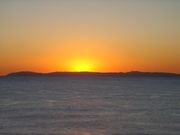
- Santa Catalina Island: Census Tract 5990 and Block Group 1, Census Tract 5991, Los Angeles County; United States Census Bureau
- Catalina Island Museum for Island History
- The Catalina Island Conservancy
- USC Wrigley Institute
- Santa Catalina Island Interpretive Center
- Collectors of Catalina Island Pottery & Tile
- Catalina Island Views (ca. 1900-1909) online photo collection, The Bancroft Library
- Maps of the Island
- Passenger Ferry to Catalina Island
- “A California Verde Antique Quarry,” 1899 Scientific American article (PDF) on Stone Quarries and Beyond. (Includes photographs and history about the American Indian olla or mortar quarry and the later serpentine quarry at Pott’s Valley, later known as Empire Landing, Santa Catalina Island.)
- An Impartial account of what it is like to know and love Catalina Island
|
|||||||
|
|||||||||||||||||
|
|||||||||||||||||||||||||

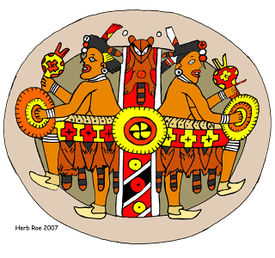
.svg.png)